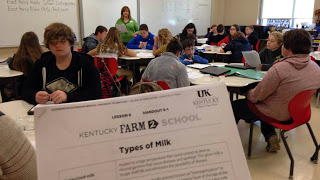Farm to School program teaches Perry County students how to eat healthier, explores local food as an industry in Eastern Ky.

 |
| Image from WYMT Mountain News |
Perry County students are learning about nutrition through the Farm to School program, which aims to inform students about healthy food while supporting local food systems,
Callie Rainey reports for WYMT-TV in Hazard.
“We teach the kids where the food comes from, how it’s produced, how you can do that in Eastern Kentucky,” Farm to School teacher Reda Fugate told Rainey. “We try to let them know that there are other industries in Eastern Kentucky that you can do other than just coal mining,” which provides half as many jobs in the eastern coalfield as it did three years ago.
About 80 Kentucky school districts and more than 200 farmers participate in the Farm to School program, Tina Garland, the state Department of Agriculture‘s coordinator for the Kentucky Farm to School program, said in a telephone interview. The latest official data says Kentucky schools spent $1.6 million on local foods in 2011-12.
Several eighth grade students in Perry County told Rainey what they had learned through the farm-to-school program.
“Too make sure that I don’t overeat and make myself sick and have the correct serving size,” said Jade Neace.
“On my plate you’re supposed to only have a certain amount of milk, meat and vegetables,” said Cayden Castle.
“I don’t eat a lot of sugars and fats and I stay healthy,” said Jade Adams.
The Farm to School program has distributed 31, $5,000 mini-grants to schools across the state to either help develop new farm-to-school programs or to enhance existing programs, Garland said.. Eleven of them were USDA Farm to School support service grants and 30 of them from the National Farm to School Network Seed Change pilot grant program, in which Perry County schools were chosen to participate.
“It actually makes you feel really good,” Fugate told Rainey. “I have a 12-year-old and knowing that they are listening and are making healthier changes so that they possibly won’t have to face some of the health issues that we as adults now have to face.”
A preliminary U.S. Department of Agriculture report finds that schools that participate in Farm to School programs show an increase in the number of meals sold, an increase in the consumption of healthier foods and decreases in plate waste.
